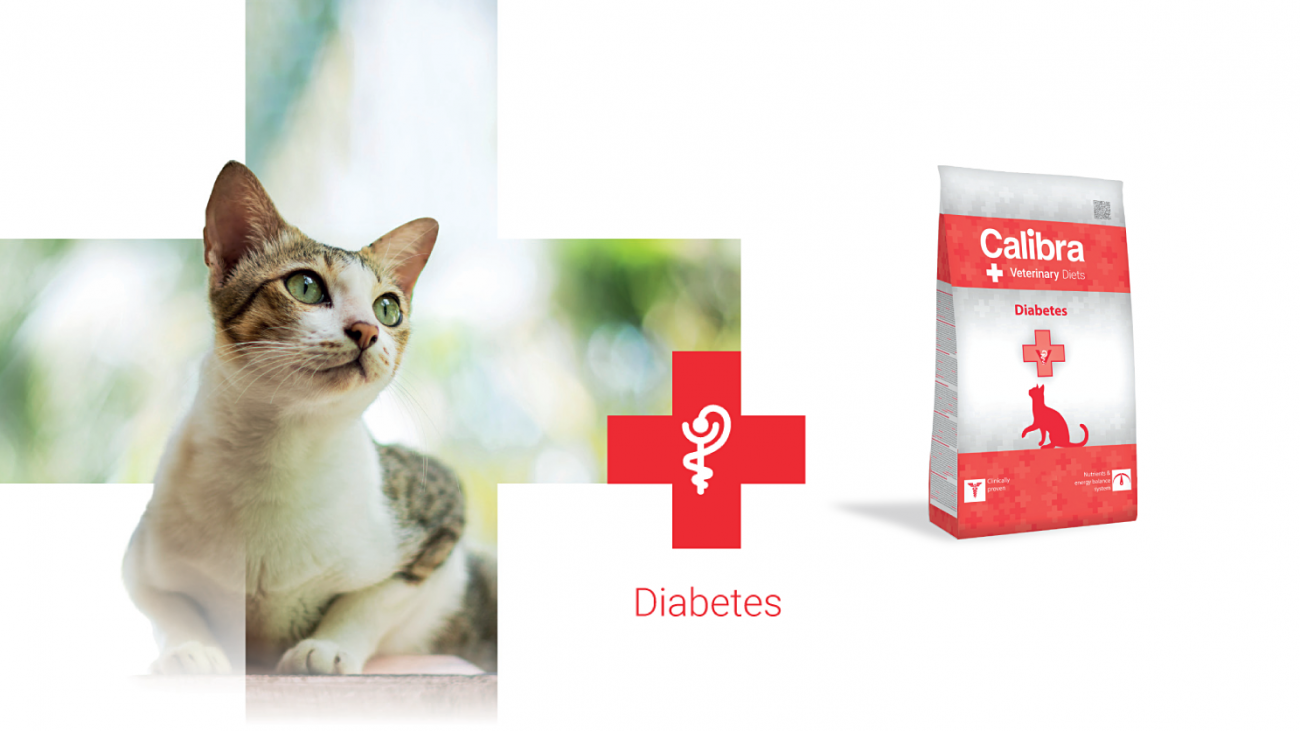Calibra VD Cat Diabetes for cats
9. February, 2022
Has your cat been diagnosed with diabetes, which unfortunately does not escape
our four-legged friends? You can help her with a properly chosen diet – one
of the possible solutions is to use the veterinary diet Calibra VD Cat Diabetes.
In this article you will learn:
- What is Diabetes mellitus and how to set the regime for diabetics
- What is the function of insulin in the body
- Why nutritional support for diabetes treatment is importantnutritional
- What makes the Calibra veterinary diet effective
What is Diabetes mellitus?
Diabetes mellitus more commonly known as diabetes, can occur in humans, dogs, and cats. It’s a condition caused by increased blood glucose levels, which can cause severe disorders throughout the body. Early treatment can prevent them.
Diabetes belongs to a group of hormonal diseases referred to as endocrinopathies.
Obesity can trigger diabetes
Obesity is a condition in which there is an overall increase in adipose tissue in an individual caused by an imbalance between caloric intake and expenditure. The animal’s lifestyle, activity levels, genetic disposition, or even neutering can influence the onset of this condition. Obesity is evaluated using the Body Condition Score (or BCS, an internationally recognized system of determining the physical condition of dogs and cats).
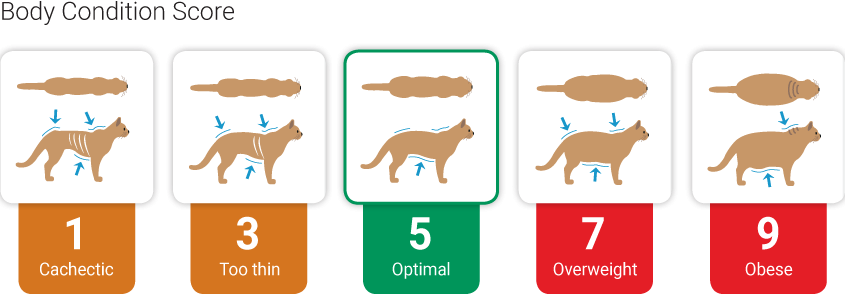
Predispositions for diabetes include:
- Age – Diabetes most commonly occurs in senior cats (over seven years old)
 Sex – Male cats are statistically more likely to suffer from diabetes
Sex – Male cats are statistically more likely to suffer from diabetes- Neutered – Neutered cats gain weight more easily and are often obese
- Obesity – One of the factors supporting the onset of diabetes
- Reduced physical activity – The lack of movement can lead to obesity and,
therefore, to diabetes - Medications – Some drugs (such as glucocorticoids) can lead to the onset
of diabetes when used long-term - Other existing general illnesses
What does insulin do?
Insulin is a hormone produced in regions of the pancreas known as pancreatic islets. Its function is to reduce blood sugar (glucose) levels and transport glucose into the cells, where it is used as a source of energy. In healthy animals, insulin is released immediately after eating.
The hormone glucagon, which is also produced in the pancreas, has the opposite effect – it raises blood sugar levels during fasting.
When insufficient quantities of insulin are produced in the body (which happens most commonly in dogs) or tissues do not react normally to insulin (a more complicated pathogenesis and different type of diabetes more common in cats), blood sugar levels rise above normal levels. Blood sugar (glucose, an osmotically active substance) attracts water molecules.
This leads to cell dehydration, increased urination, increased thirst, and therefore to overall dehydration of the body. Glucose levels are high in the blood, but low in the cells, because its transport into the cells is reduced. Glucose provides energy. If cells lack energy, appetite is increased.
The animal starts to take in more food, but paradoxically, it loses weight. This leads to changes in cell metabolism,
ketosis, and ketoacidosis. Increased blood sugar also influences tissues, such as neural tissue and muscles, affecting their structure and thus their functioning.
The clinical symptoms of diabetes, which are very complex, derive from these processes.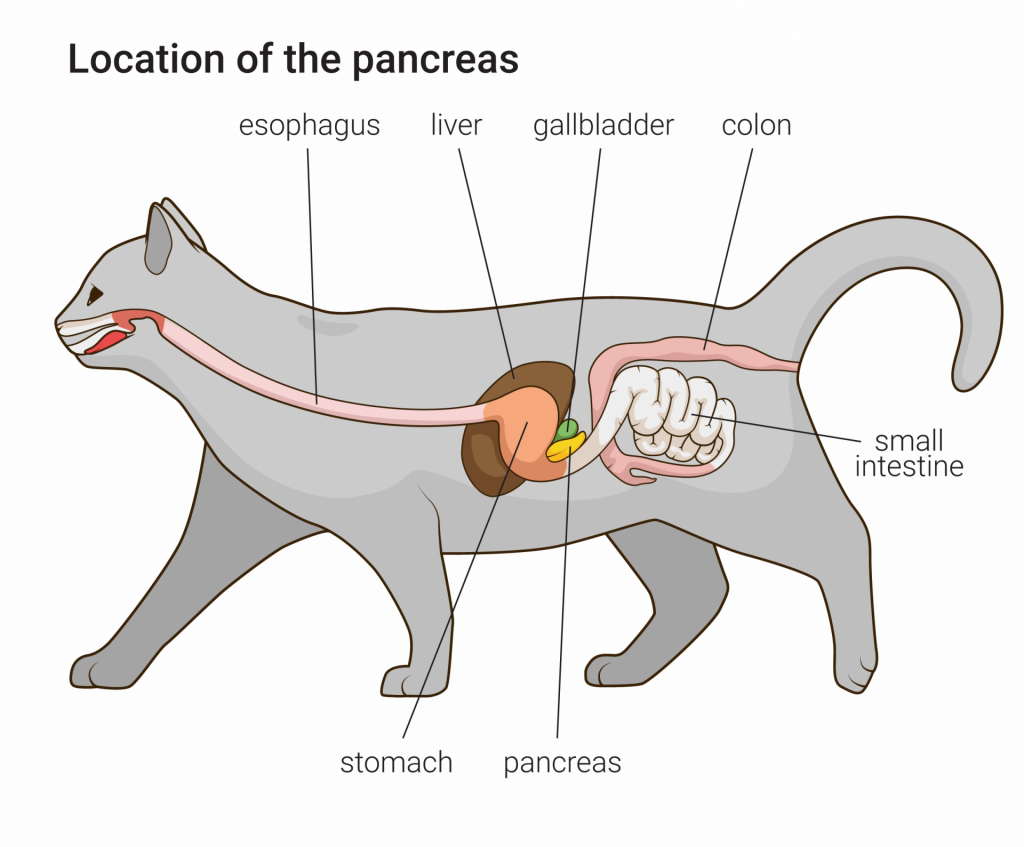
Clinical symptoms of diabetes in cats:
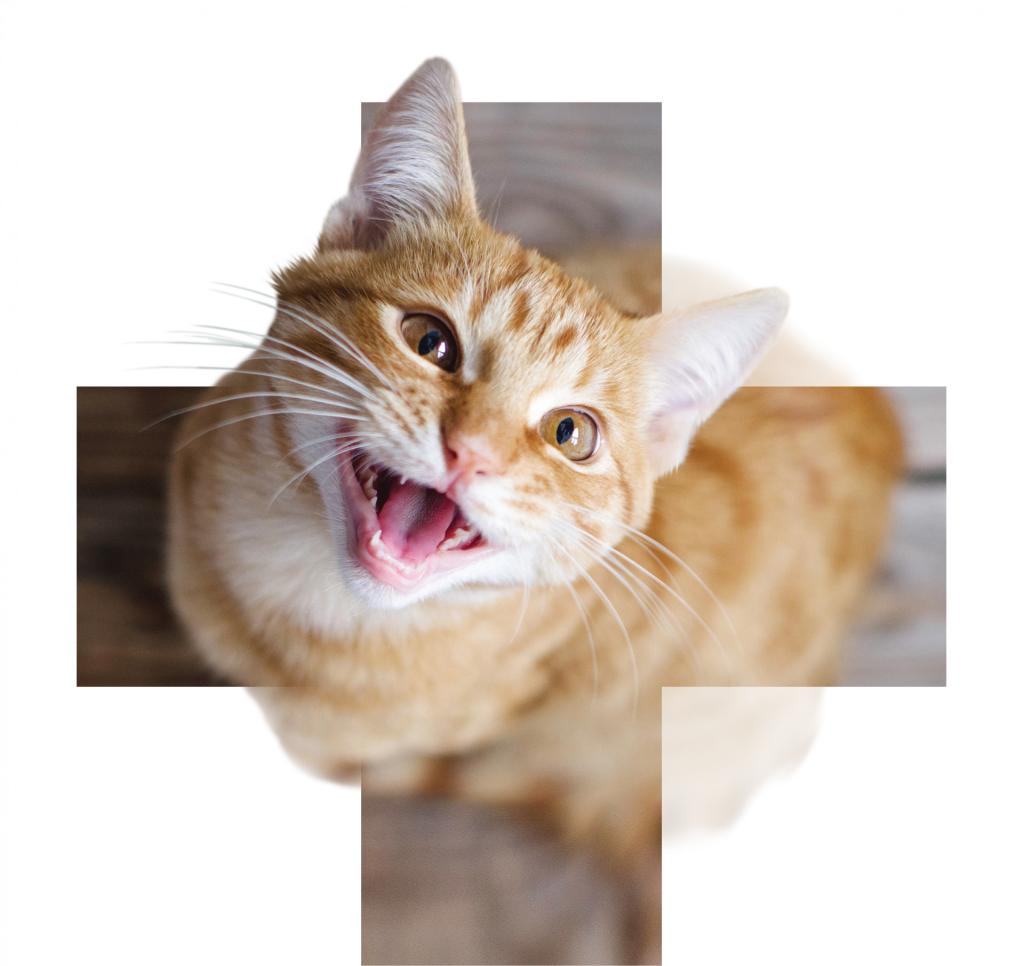 Frequent urination, larger urinary volume (polyuria)
Frequent urination, larger urinary volume (polyuria)- Increased water intake and thirst (polydipsia)
- Persistent hunger and overeating (polyphagia)
- Sudden weight loss despite increased food intake
- Dehydration (dry mucous membranes, reduced skin elasticity)
- Weakened limbs (inability to jump)
- Loss of muscle mass
Diabetes must be treated as quickly as possible
Long-term effects of high blood sugar levels in diabetes that can be avoided with early treatment include:
- Diabetic neuropathy – A nervous disorder presenting as pain, reduced sensitivity (up to complete numbness) of hindlimbs
- Diabetic retinopathy – A disease of the retina caused by damage to blood vessels that nourish the retina. It can lead to blood leakage into the eye, which can cause serious vision impairment and even blindness.
- Diabetic cataracts – Visual impairment.
Nutritional support for diabetes treatment is important
Diabetes cannot be cured. In cats, proper treatment (administration of insulin) and the introduction of a veterinary diet can lead to remission. Diabetic remission means that clinical symptoms and manifestations of the disease disappear. In remission, cats can live without insulin therapy – using only a veterinary diet adapted for diabetic cats. Regular checkups by a veterinarian are essential.
Veterinary diets for cats with diabetes are specially formulated to provide a support:
- Reduced carbohydrate content to control blood sugar levels.
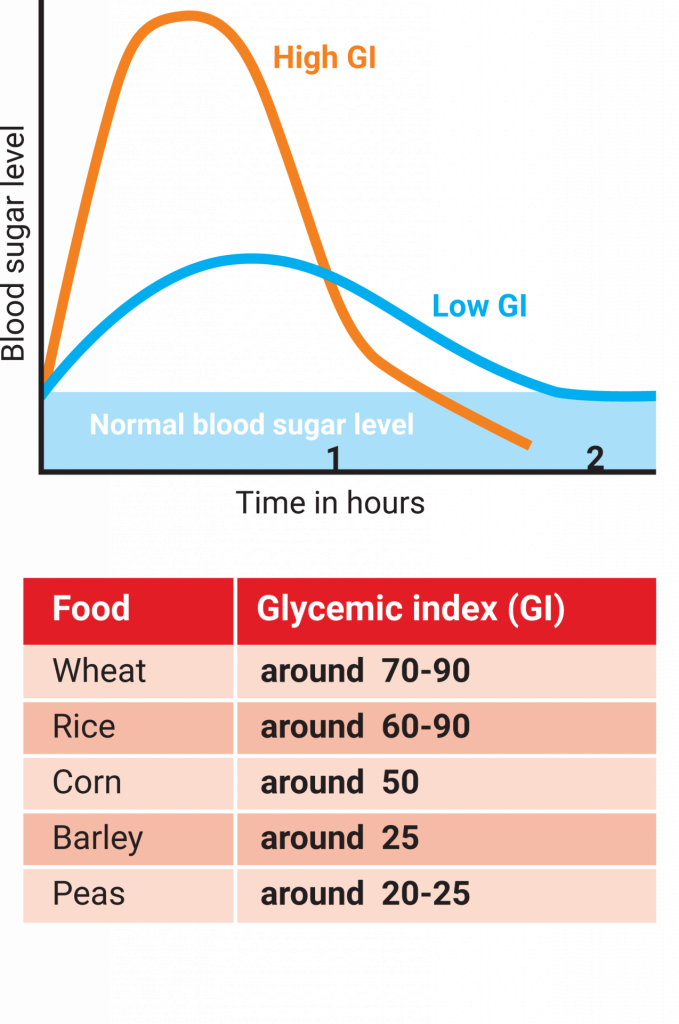 Sources of carbohydrates with a low glycemic index, which enable better control of postprandial glycemia, or blood sugar levels after eating.
Sources of carbohydrates with a low glycemic index, which enable better control of postprandial glycemia, or blood sugar levels after eating.- High protein content helps maintain lean muscle mass.
- High antioxidant content prevents disruption of metabolic processes and cell membrane damage (diabetes contributes to oxidative stress).
- Increased fiber content lowers the food’s caloric content, while also inducing a feelingof satiety. The cat can lose weight or maintain an optimal weight without feeling hungry or without the necessity to reduce portion sizes. Fiber also supports intestinal function and acts as food for friendly intestinal bacteria; it acts as a prebiotic.
- Probiotics for digestive support.
How to properly schedule insulin administration and feeding?
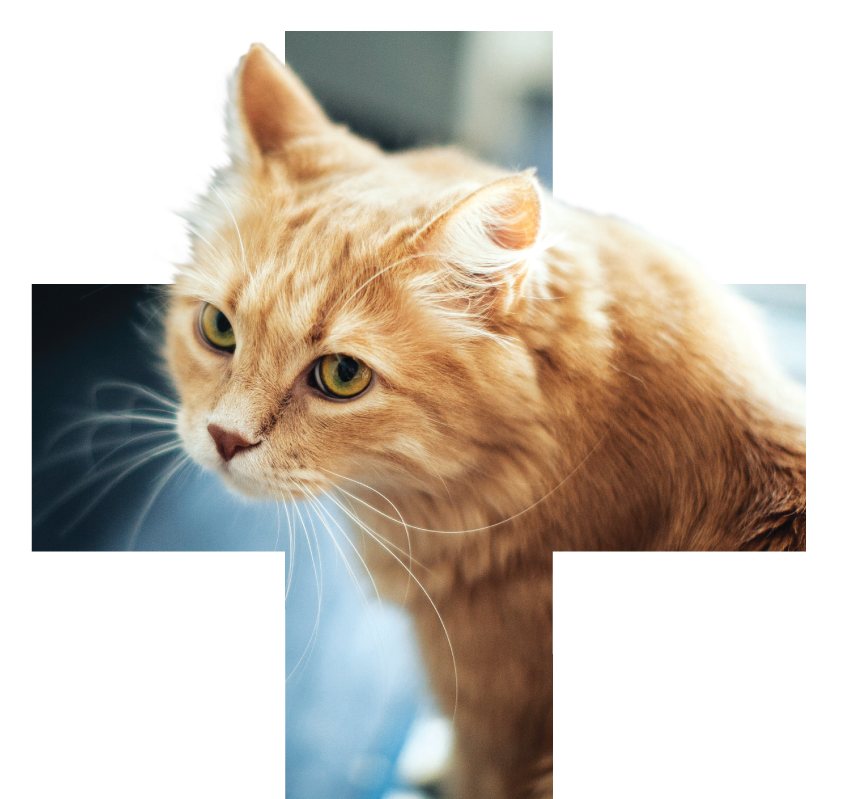 It‘s always important to follow the instructions of your veterinarian and to adhere to the patient’s individual treatment plan. It is necessary to coordinate the feeding and insulin administration times to ensure that sugar from the food enters the blood at the right time the insulin is absorbed.
It‘s always important to follow the instructions of your veterinarian and to adhere to the patient’s individual treatment plan. It is necessary to coordinate the feeding and insulin administration times to ensure that sugar from the food enters the blood at the right time the insulin is absorbed.
If insulin is administered too early, the animal can become hypoglycemic (very low blood sugar and risk of collapse); if administered too late, the animal can become hyperglycemic (very high blood sugar and the associated risks).
Feeding intervals depend on the type of insulin used and are determined by the veterinarian. Successful therapy lies in perfect compliance with the veterinarian’s instructions.
What does Calibra offer?
Calibra has developed the Calibra VD Diabetes veterinary diet for cats to provide nutritional support for diabetes mellitus. This veterinary diet includes the Nutrients & Energy Balance System – a combination of substances that provide optimum nutrition with a balanced calorie content.
- [#product-1388]The high protein Chicken & Egg recipe uses chicken protein and dehydrated eggs.
Eggs are the “gold standard” of quality protein - they have the best amino acid composition and digestibility. - Low carbohydrate content – very low in starch.
- Increased fiber content.
- METABOLIC MANAGEMENT COMPLEX – A special combination of substances to optimize glucose uptake:
Sources of starch with a low glycemic index (corn, barley).
High L-carnitine content (supports fat burning).
Vitamins and antioxidants – polyphenols and flavonoids from green tea and turmeric, which act against free radicals, preventing oxidative stress.
Complex approach of Calibra – in addition chondroprotectives focused on support of the musculoskeletal system.
- Glucosamine is physiologically created in joint cartilage; it is part of joint tissue (ligaments, tendons, cartilage).
- Chondroitin sulfate – one of the building blocks of joint tissue. Both substances are found normally and naturally in the body.
 The Diabetes veterinary diet helps:
The Diabetes veterinary diet helps:
- with Diabetes mellitus treatment
- reduce excess weight/obesity
- maintain optimal weight
Important!!!
Regular feeding with smaller portions of food, always in coordination with insulin, is essential for maintaining a constant (steady) blood sugar level.
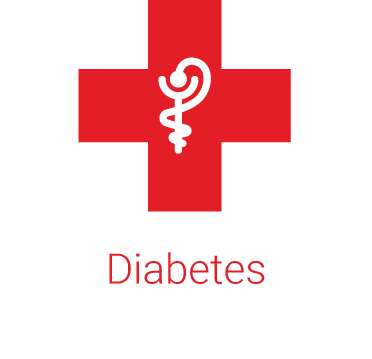 Other supplements to the veterinary diet (pouches/ canned food) should be given only with veterinary approval, and only in limited quantities. Some can contain carbohydrates with a high glycemic index that can increase blood sugar levels and cause a worsening of the animal‘s condition.
Other supplements to the veterinary diet (pouches/ canned food) should be given only with veterinary approval, and only in limited quantities. Some can contain carbohydrates with a high glycemic index that can increase blood sugar levels and cause a worsening of the animal‘s condition.
...and finally….
Calibra VD Diabetes for cats has been specially developed by veterinarians based on the latest scientific findings. Today, veterinary diets lie somewhere between medicine and food, and help support medical treatment in the most natural way.
